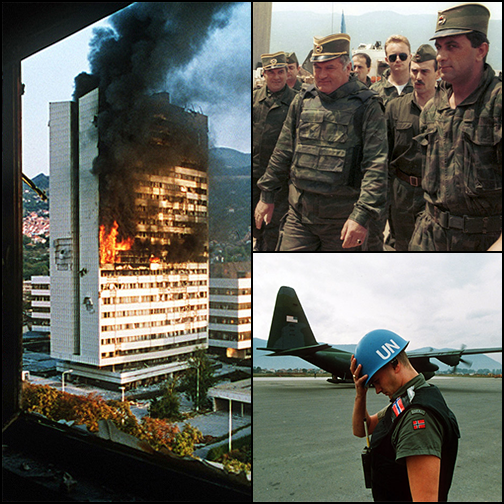War in Bosnia
| Bosnian War | ||||||||
|---|---|---|---|---|---|---|---|---|
| Part of the Yugoslav Wars | ||||||||
 The executive council building burns after being hit by artillery fire in Sarajevo May 1992; Ratko Mladić with Army of Republika Srpska officers; a Norwegian UN soldier in Sarajevo. |
||||||||
|
||||||||
| Belligerents | ||||||||
|
1992: |
1992: |
|||||||
|
1992–94: |
1992–94: |
1992–1994: Supported by: |
||||||
|
1994–95: (bombing operations, 1995) |
1994–1995: Supported by: |
|||||||
| Commanders and leaders | ||||||||
|
|
(Vice president of CR Herzeg-Bosnia) …and others |
|
||||||
| Strength | ||||||||
|
ARBiH: 110,000 troops 100,000 reserves 40 tanks 30 APCs |
HVO: 45,000–50,000 troops 75 tanks 50 APCs 200 artillery pieces HV: 15,000 troops |
VRS: 80,000 troops 300 tanks 700 APCs 800 artillery pieces AP Western Bosnia: 4,000–5,000 troops |
||||||
| Casualties and losses | ||||||||
| 30,521 soldiers killed 31,583 civilians killed |
6,000 soldiers killed 2,484 civilians killed |
21,173 soldiers killed 4,179 civilians killed |
||||||
| additional 5,100 killed whose ethnicity and status are unstated | ||||||||
|
a From 1992 to 1994, the Republic of Bosnia and Herzegovina was not supported by the majority of Bosnian Croats and Serbs. Consequently, it represented mainly the Bosnian Muslims. b Between 1994 and 1995, the Republic of Bosnia and Herzegovina was supported and represented by both Bosnian Muslims and Bosnian Croats. This was primarily because of the Washington Agreement. |
||||||||
|
Total dead or disappeared 101,040 (total includes unknown status below, percentages ignore 'unknowns') |
Bosniaks | 62,013 | 61.4% |
| Serbs | 24,953 | 24.7% | |
| Croats | 8,403 | 8.3% | |
| Other ethnicities | 571 | 0.6% | |
|
Civilians 38,239 (percentages are of civilian dead) |
Bosniaks | 31,107 | 81.3% |
| Serbs | 4,178 | 10.9% | |
| Croats | 2,484 | 6.5% | |
| Other ethnicities | 470 | 1.2% | |
|
Soldiers 57,701 (percentages are of military dead) |
Bosniaks | 30,906 | 53.6% |
| Serbs | 20,775 | 36% | |
| Croats | 5,919 | 10.3% | |
| Other ethnicities | 101 | 0.2% | |
|
Unknown status (percentage is of all dead or disappeared) |
Ethnicity unstated | 5,100 | 5% |
|
Total killed 104,732 |
Bosniaks | c. 68,101 |
| Serbs | c. 22,779 | |
| Croats | c. 8,858 | |
| Others | c. 4,995 | |
|
Civilians killed 36,700 |
Bosniaks | 25,609 |
| Serbs | 7,480 | |
| Croats | 1,675 | |
| Others | 1,935 | |
|
Soldiers killed 68,031 (includes Police) |
Bosniaks | 42,492 |
| Serbs | 15,298 | |
| Croats | 7,182 | |
| Others | 3,058 |
Military stalemate
1992:
1992:
1992–94:
1992–94:
1992–1994:
1994–95:
1994–1995:
![]() Alija Izetbegović
Alija Izetbegović
(President of Bosnia and Herzegovina) ![]() Haris Silajdžić
Haris Silajdžić
(Prime Minister of Bosnia and Herzegovina) ![]() Sefer Halilović
Sefer Halilović
(ARBiH Chief of Staff 1992–1993) ![]() Rasim Delić
Rasim Delić
(ARBiH Commander of the General Staff 1993–1995) ![]() Enver Hadžihasanović
Enver Hadžihasanović
(ARBiH Chief of Staff 1992–1993)
...
Wikipedia
